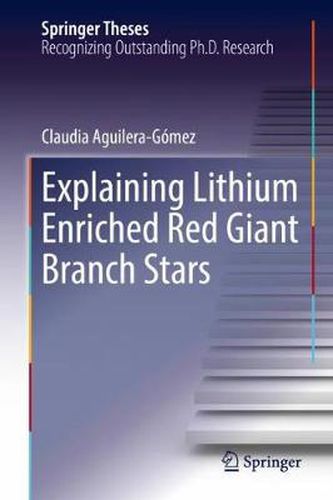Readings Newsletter
Become a Readings Member to make your shopping experience even easier.
Sign in or sign up for free!
You’re not far away from qualifying for FREE standard shipping within Australia
You’ve qualified for FREE standard shipping within Australia
The cart is loading…






This title is printed to order. This book may have been self-published. If so, we cannot guarantee the quality of the content. In the main most books will have gone through the editing process however some may not. We therefore suggest that you be aware of this before ordering this book. If in doubt check either the author or publisher’s details as we are unable to accept any returns unless they are faulty. Please contact us if you have any questions.
This thesis provides new insights into the seemingly anomalous ubiquity of lithium-rich red giant stars. The theory of stellar evolution, one of the most successful models of modern astrophysics, predicts that red giant stars should display negligible levels of lithium (Li) on their surfaces. However, Li-rich giants, defined as those showing more than three times the Li content of the Sun, are found everywhere astronomers look in apparent defiance of established theory.
The author addresses this problem, analyzing the different possible explanations for such an anomaly, which include interaction with a binary companion, the production of Li in the interior of the star with its subsequent transport to stellar exteriors, and the stellar interaction with planets. The author focuses on this last possibility, where the Li enrichment may be due to the ingestion of planets or brown dwarfs as the stars in question grew in size while becoming giants. She shows that this process is indeed able to explain an important fraction of giants with Li levels above the three times solar threshold, but that some other mechanism is needed to explain the remaining fraction. While this is an important discovery in its own right, the result that makes this thesis groundbreaking is its demonstration that the threshold between Li-normal and Li-rich is mass dependent rather than a fixed proportion of the Sun’s content. This corrects a fundamental misapprehension of the phenomenon and opens up a new framework in which to understand and solve the problem.
Finally, the author presents interesting observational applications and samples with which to test this new approach to the problem of Li enrichment in giants.
$9.00 standard shipping within Australia
FREE standard shipping within Australia for orders over $100.00
Express & International shipping calculated at checkout
This title is printed to order. This book may have been self-published. If so, we cannot guarantee the quality of the content. In the main most books will have gone through the editing process however some may not. We therefore suggest that you be aware of this before ordering this book. If in doubt check either the author or publisher’s details as we are unable to accept any returns unless they are faulty. Please contact us if you have any questions.
This thesis provides new insights into the seemingly anomalous ubiquity of lithium-rich red giant stars. The theory of stellar evolution, one of the most successful models of modern astrophysics, predicts that red giant stars should display negligible levels of lithium (Li) on their surfaces. However, Li-rich giants, defined as those showing more than three times the Li content of the Sun, are found everywhere astronomers look in apparent defiance of established theory.
The author addresses this problem, analyzing the different possible explanations for such an anomaly, which include interaction with a binary companion, the production of Li in the interior of the star with its subsequent transport to stellar exteriors, and the stellar interaction with planets. The author focuses on this last possibility, where the Li enrichment may be due to the ingestion of planets or brown dwarfs as the stars in question grew in size while becoming giants. She shows that this process is indeed able to explain an important fraction of giants with Li levels above the three times solar threshold, but that some other mechanism is needed to explain the remaining fraction. While this is an important discovery in its own right, the result that makes this thesis groundbreaking is its demonstration that the threshold between Li-normal and Li-rich is mass dependent rather than a fixed proportion of the Sun’s content. This corrects a fundamental misapprehension of the phenomenon and opens up a new framework in which to understand and solve the problem.
Finally, the author presents interesting observational applications and samples with which to test this new approach to the problem of Li enrichment in giants.